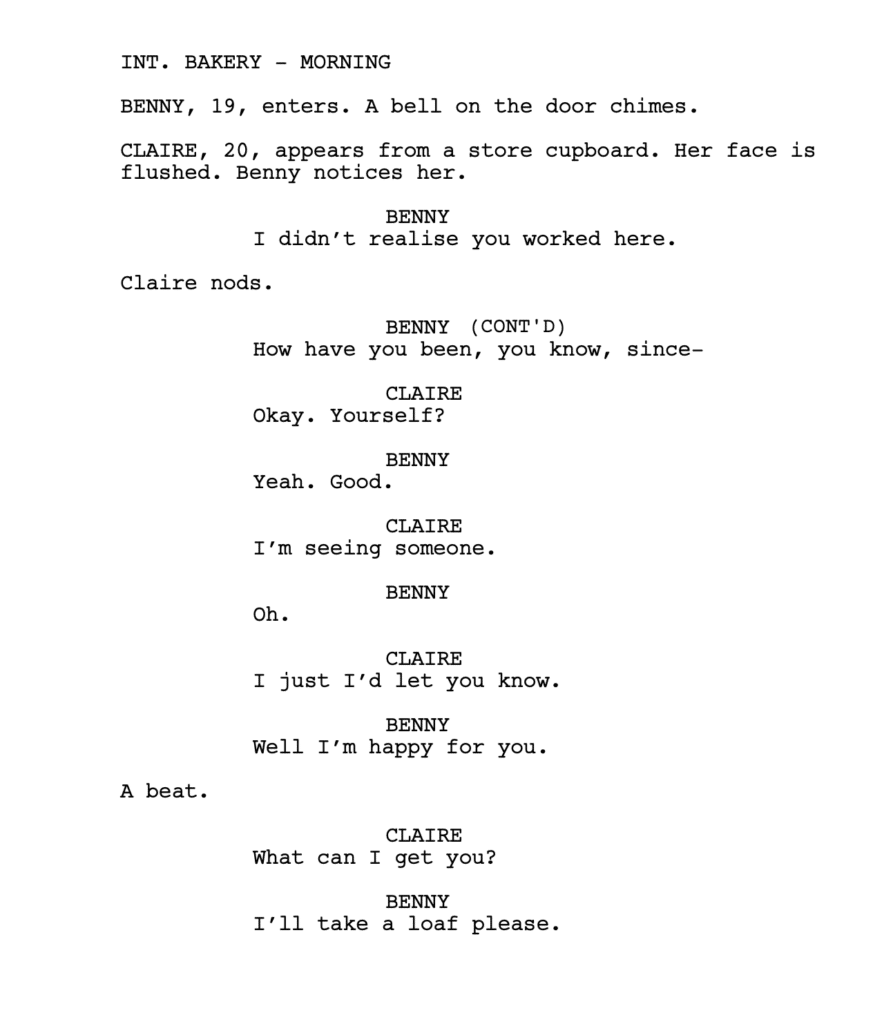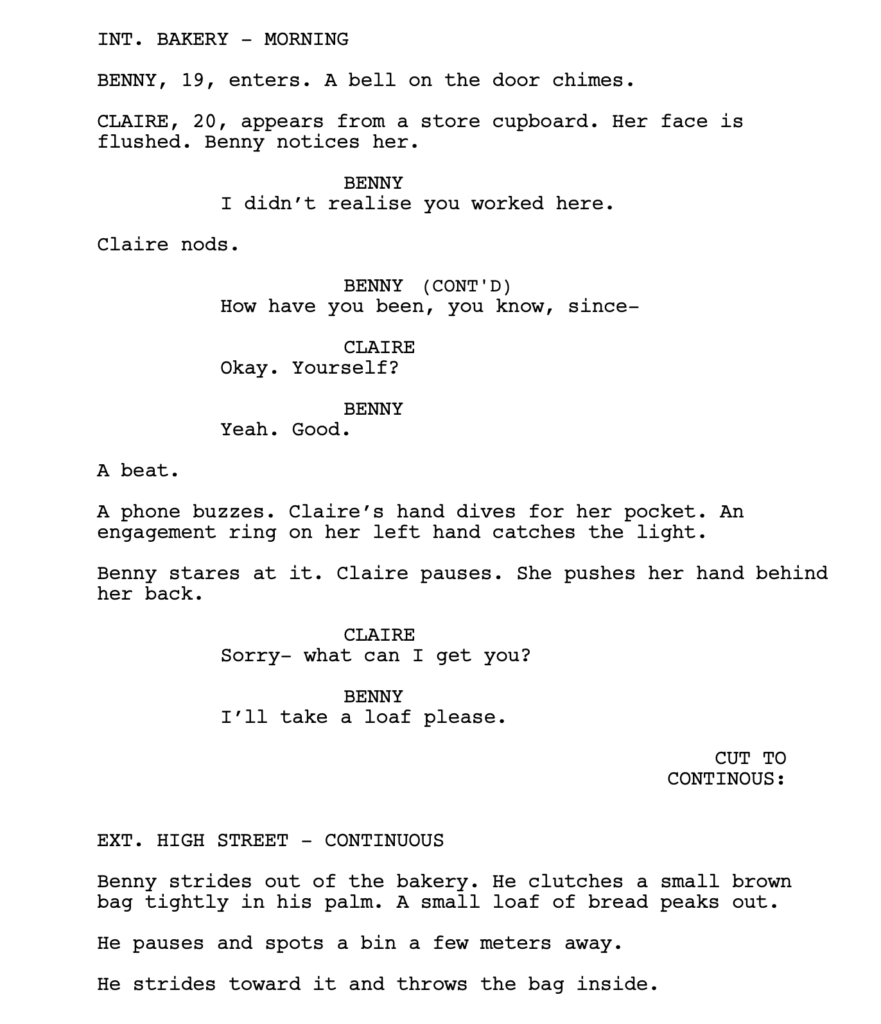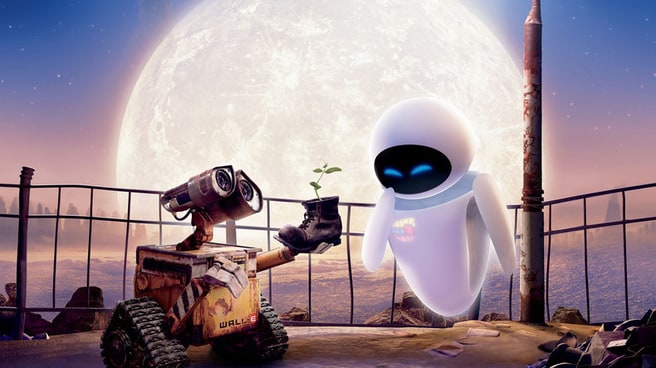Table of Contents
What Is Visual Storytelling?
By definition, visual storytelling is a story told through a visual medium. This can include anything from photography, video or illustration, which is then enhanced by the use of music, sound or audio.
When considering the very beginning of cinematic history, visual storytelling was all that filmmakers were limited to. Until the introduction of audio within film, all cinema-makers could do was show and not tell. The very fact that film began solely as a visual art suggests just how important visual storytelling should be within screenwriting.
The goal of visual storytelling is to convey complex thoughts and emotions without the use of much dialogue. Many filmmakers believe that some of the best scenes ever written follow this rule. To get a better sense of this idea, let’s take a look at the following two examples…
Within both of these scenes, Benny walks into a bakery and sees his ex-girlfriend working behind the counter.

In this example, Claire announces she is seeing someone else. While this may be a completely realistic scenario, consider how the version below compares…

Now Consider, Which Scene Would Be More Engaging For An Audience to Watch?
Not only is it more interesting to visually see that Claire has moved on, but Benny’s reaction when he leaves the store creates a more engaging hook for an audience. Why would Benny throw the bread away? Did he know Claire worked there all along? Had he gone in to speak to her?
This may not be the most exciting of scenes either way. But the key point here is that while dialogue can create engaging moments onscreen, what many screenwriters tend to forget is that film is a visual medium. Dialogue can say a lot about a character, but so can what an audience sees.
To apply this concept, writers must consider the vital lesson of ‘show don’t tell‘. For decades, filmmakers have made some of the greatest films in the world without a single word of dialogue.
Still not convinced? Consider the very concept of a silent film. For years, this was all filmmakers were limited to but still to this day, people watch and enjoy silent films. It is fair to say this isn’t necessarily an acquired taste either- as seen with the box office success of A Quiet Place.
How Does Visual Storytelling Work In Screenplays?
In relation to how visual storytelling works in screenplays specifically, it is best to consider what visual storytelling includes.
Consider all of the visual descriptions within a script:
- Location
- Character appearance
- Action
Anything within your script that aims to create a visual picture can be considered visual storytelling. For example, something as simple as Benny staring at Claire’s engagement ring in the above scene example.
While novels and plays allow a writer to demonstrate what a character is thinking, either through lengthy descriptions or monologues, screenplays rely solely on what a character does.
A screenwriter can’t write what a character is thinking. Instead, they must show it. In relation to Benny again, a writer can’t write a paragraph on the heartache Benny feels at the sight of Claire’s ring, instead, they must show how he feels. While the action of throwing a loaf of bread in the bin may be a simple one, it displays Benny’s anger in a matter of seconds. After all, actions speak far louder than words.
Visual storytelling can also be used to show a lot in a short space of time. One of the most famous and loved examples of this can be seen in the opening to Pixar’s UP…
WARNING: This one certainly is a tear-jerker!
This scene is highly recognised as one that engages audiences with very minimal dialogue and creates the perfect opportunity for an audience to invest within the characters’ journey.
Not only does the montage give an audience a clear sense of Carl and Ellie’s relationship, but it also shows their goals (saving for paradise falls). This four-minute sequence is so complex that it could have been the whole movie’s plot, yet Pixar executes it in an incredibly effectively montage.
How Does This Up Scene Work?
Within the first thirty seconds of the montage, the two families at the church display the contrasting sides of Carl and Ellie perfectly, with Ellie’s side shouting and cheering against the mundane, straight-faced relatives of Carl.
- An audience doesn’t need long, dialogue-heavy scenes to understand that the two characters come from opposite worlds- the use of two strong visuals can inform an audience so in the space of a few seconds.
As the story develops, the images of newlyweds creating their own home and family is something that can be universally understood by anyone.
Additionally, the use of clouds to display their desire for a child is incredibly effective.
- Clouds are often associated with dreams, which everyone in the audience can be expected to understand, subconsciously or consciously.
- This, when contrasted with the dark colours used when Ellie loses her baby, reinforces the heartbreak visually.
- We experience the transition of hopes and dreams to loss and grief with Carl and Ellie as it happens.
- We also don’t need to hear from the doctor that Ellie has miscarried, the body language from all the characters in the scene alone conveys all that we need to know.
To convey the passage of time, we see the same actions and images repeated.
- For example, the repetition of the money jar being filled up and then smashed visually reflects the setbacks everyone in life has in achieving their dreams.
- The ‘everyday’ nature of the montage allows an audience to instantly connect with their story.
By the end of the four minutes, if you can still see through all of your tears that is, audiences are ready for the story of Up to unfold. Having already invested in Carl, an audience can be expected to root for him from the very beginning.
Why Is Visual Storytelling So Important?
So why is visual storytelling so important? Let’s put it simply. Would you rather listen to your best friend tell you about the best day of their life or live it with them? Audiences don’t just want to be told a story, they want to experience one.
When developing screenplays, many writers strive for ‘that moment‘. The moment that audiences leave the cinema thinking about and one that encompasses the film as a whole.
Some memorable examples include…
1. Titanic
- While this scene in Titanic does include some dialogue, it’s fair to say it’s one of the most iconic visual moments in cinematic history.
- In a world where Jack and Rose must battle social issues in order to even consider being together, the image of them isolated, almost ‘flying’, can reflect the idea that their love for each other transcends everything, regardless of where they both come from. The sight of them alone at sea with each other suggests that they are all each other needs.
- It also suggests this is where they will forever be, foreshadowing Jack’s death and the fact that their love will only ever get the chance to exist at sea, on this ship.
- Visual storytelling often excels when it encompasses ideas that viewers can connect with. In this case, many audience members may relate to the dream of being swept off their feet by love.
2. Wall-E
- Wall-E is one of the most recognised films in visual storytelling discussions. Throughout the whole film, Wall-E and Eva only use two words- their names. This leaves the filmmakers with no choice but to show every emotion through interaction and expressions only.
- In the above scene, Wall-E’s drive home informs an audience about so much of the world he lives in within the space of just two minutes.
- The barren colours suggest a dystopian future and reflect Wall-E’s mundane and repetitive life. Wide shots of the city and world suggest that this isn’t a localised issue, and the image of Wall-E driving past a broken robot like himself in a rubbish pile suggests he’s the only one left. This is reinforced by the visual of Wall-E being alone in such a vast space. Furthermore, the very fact that Wall-E appears unfazed by what he sees tells us that this is all normal for him.
- Set around the concept of a journey home, this sequence is also something that all audiences can relate to. Universal concepts and activities allow an audience to engage in what they see as they themselves have all experienced the mundane cycle of going to and from work.
3. Psycho
- In Psycho, the decision to set this scene (above) in a shower is incredibly clever.
- As mentioned previously, visual storytelling works exceptionally well when it is an image that an audience can relate to.
- In this instance, everyone showers, so everyone can relate to the fear someone would feel in seeing a face at the shower curtain.
- This is heightened by the tension built up as the audience sees the murderer before Janet does. Not only is this a chilling image in itself, but audience members can expect to jump to the edge of their seat, itching for Janet to realise what is behind her before it’s too late.
- Visual storytelling often plays on symbols that are universal for all audience members. The image of Janet’s eye after she is murdered is clever as eyes are often associated with being the ‘life of a person’, the truth, omniscience or as a gateway to the soul. Hence, when an audience is confronted with the cold, lifeless visual of an eye, it provides a stark contrast to the bright eyes we saw at the start of the scene.
What Do These Scenes Have In Common Though?
Not only do these scenes all have a clear absence of much dialogue, but they also have the very fact that the characters’ actions are what we remember most. The images we take away from movies are most notably stronger than the lines of dialogue we can recall.
This isn’t to say dialogue isn’t important- it most certainly is. If anything, it reinforces the need for succinct and relevant dialogue that develops a story and informs us about a character or their goal.
Additionally, consider what it is that you want an audience to see. Try and avoid creating ‘a moment’ simply for the sake of it. Many writers might argue the moment they had in mind while writing their screenplay is never actually the moment that an audience picks out in the end.
Also consider why you want your audience to see this ‘moment’. Does it develop the story? Highlight something new about a character or relationship? Resolve a conflict?
Visual storytelling is relevant for providing the audience with information in a way that enables them to connect or relate to a character, which in hand allows them to feel as if they are experiencing the journey with them.
Visual storytelling is also incredibly important for the development stages of production. Not only do you have to show the audience what you want to say, but you also need to ensure it’s clear to an actor or director what you want to be expressed within a scene. There’s no specific guide to this- every writer has their own style. Though, there are some key things to consider…
How To Approach Visual Storytelling?
So you understand what Visual storytelling is, but how do you apply this to your own writing?
Here are three key points to consider…
1. An Opener
Opening scenes have always been important. But as the film market changes and evolves, the opening of your film has never been more significant.
In a traditional cinema landscape, the likelihood of a cinema-goer upping and leaving five minutes into a film is incredibly low. With the likes of Netflix however, this is far from a rarity. For this reason, your opening needs to be strong.
In trying to get your screenplay read as well, the opening is very important. Screenplay readers often reiterate that they won’t read past the first fifteen pages if it doesn’t grab them.
Think about what it is you want to say. What is the tone of your film? Can this be established in your opening sequence? What type of world are we in? Is your character well accustomed to that world or are they in a new place?
A visual image can tell an audience a lot within a small space of time- and you may well find it does some important expositional work for you.
2. Chains of Dialogue
As mentioned, dialogue can tell us a lot about what a character is feeling or thinking. It may be appropriate for elements of your screenplay to involve lengthy conversations between two characters. However, always consider what it is you’re trying to say. What is the purpose of the scene? Does it contribute to the narrative arc?
A good way to approach this is to consider exactly what you want to achieve and set your character a limit on how much dialogue they can deliver.
For example, let’s go back to Benny again. The goal of writing that scene is to establish that Claire is now engaged and that Benny is unhappy about it. Simple enough, right? Try writing that scene with a limit of two lines for both Benny and Claire. How does this force you to use the visual medium more effectively?
3. Setting
The first step in establishing a strong, visual setting in your screenplay is to think about why you want to set your story in a specific place. If you can’t pinpoint why- this may be your first problem.
While it is important to create a setting that is visually interesting and engaging, it’s also important to not lose sight of how this contributes to your story.
- For example, if you’ve set your screenplay in space, use this to your advantage. Keep your characters active and struggling with obstacles their environment may produce.
- That isn’t to say an audience would want to see ninety minutes of someone bouncing on the moon, but the concept of gravity, for example, could be used to heighten the stakes at relevant points of the story.
- Make your environment relevant to your story rather than including it just because it ‘looks cool’.
This also doesn’t mean that your screenplay has to be set in the most extravagant and outlandish setting possible. As seen in Twelve Angry Men, the simple setting of a jury room is very effective.
- The concept alone of twelve men stuck in a room with a tense decision to make is engaging.
- The setting then raises the tension as the story develops and the men grow increasingly desperate to leave.
- If the jury had been stuck in a big hall, with lots of air and bright sunlight, how would this have altered the course of the story?
In essence, remember that you chose your setting for a reason. Make sure your story is one that can only be told in that one specific place, at that one specific time, and always consider why.
Setting is as much of a device as characters, action and dialogue are. Don’t overlook it!
In Summary
Visual Storytelling includes any description within your script that paints a picture. One key thing to always refer back to is ‘show, don’t tell‘. An image can speak a thousand words and film is a visual medium after all.
From character descriptions, actions and setting, visual storytelling should be at the heart of your script. This can tell us everything that dialogue may not.
An audience would much rather see something happen than simply being told about it. It also enhances their ability to connect and relate to a character.
Three key things to remember here is- to create a strong opener, avoid chains of unnecessary dialogue and use your setting to enhance your story, not distract from it.
– What did you think of this article? Share It, Like It, give it a rating, and let us know your thoughts in the comments box further down…
– Struggling with a script or book? Story analysis is what we do, all day, every day… check out our range of script coverage services for writers & filmmakers.
This article was written by Georgia Bishop and edited by IS Staff.
Get *ALL* our FREE Resources
Tackle the trickiest areas of screenwriting with our exclusive eBooks. Get all our FREE resources when you join 60,000 filmmakers on our mailing list!


ensuring that if the writer is mindful of the reader at all times, making visible the proofreading strategies writers need to enact. “I’m not sure about my spelling of that word extrovert. Let me say it slowly in syllables ex-tro-vert. What sounds do I hear? How might I record them? Does it look right? I better check using a dictionary or spell check”
Brilliant & helpful article. Thanks for sharing your insights.
Most welcome Paul, so glad we could help you out a little…
Great article. Some excellent examples before i sit down to work on a re-write!!
Thanks Alex, so glad you found it helpful!